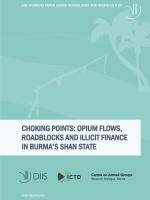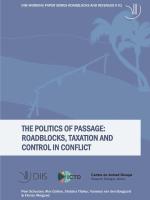Choking points
The flow of opium presented unique opportunities and challenges for the Burmese armed groups interested in profiting from its concentrated wealth. In this working paper, John Buchanan explores the emerging features of armed group predation tied to the explosive growth of Shan State’s opium sector from the 1950s to the 1990s, arguing that the properties of opium, the physical terrain and varying state capacities, created opportunities and constraints for armed groups to profit from the opium trade. His study shows a need for moving beyond a focus on the presence of valuable resources and opportunities for revenue generation. Instead, Buchanan urges us to consider the properties of commodities, the intricacies of logistics, and the affordances of terrain in shaping the politics of passage.
This paper is the third in a new working paper series on Roadblocks and revenues, a collaboration between DIIS, the International Centre for Tax and Development and the Centre on Armed Groups. You can read the first paper, which introduces the working paper series, here, and the second one, which focuses on Afghanistan, here.
The working paper series is generously funded by the Carlsberg Foundation under the Semper Ardens: Accelerate grant ‘TRADECRAFT’. Read more about the project here.




